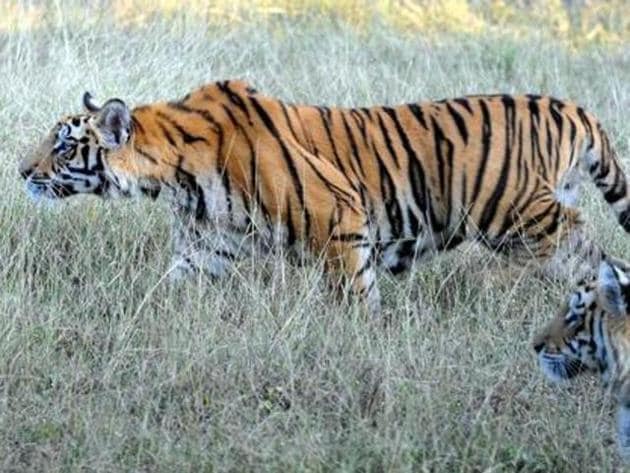Maximum tiger mortality, body parts seizures from Maharashtra in 2017
Despite not having the largest number of tiger, the total mortality was the highest in Maharashtra.
Mumbai: Despite Maharashtra not having the highest tiger population in the country, the state has recorded the maximum tiger deaths plus body parts seizures this year so far.

On World Tiger Day, data from the National Tiger Conservation Authority (NTCA), a statutory body under the Ministry of Environment, Forests and Climate Change (MoEF&CC), revealed that Maharashtra recorded 16 tiger deaths in 2017 so far - 12 natural deaths and four cases of body parts seizures. Last year, the state recorded 16 natural deaths and only one case of body parts seizure.
Between June 27 and July 3, six persons were arrested for poaching two tigers at the Pench Tiger Reserve, Maharashtra. Forest officials said this was one of the largest poaching rackets in the state in the past five years. Another tiger is believed to have been killed close to the reserve by the accused as the forest department continues to investigate the matter.
As compared, Madhya Pradesh with 308 tigers, recorded 14 tiger deaths in 2017 so far - 13 owing natural causes and one case of body part seizure. Last year, however Madhya Pradesh recorded the maximum tiger deaths with 30 cases.
Karnataka, home to 406 tigers, recorded the third highest mortalities at 13 - 12 natural deaths and one body part seized.
Tigers are protected under Schedule 1 of the Wildlife Protection Act, 1986. According to the state forest department, there are 202 tigers currently across the state.
NTCA officials said that the increase in tiger deaths in Maharashtra indicated increased vigilance and more detection by the forest department. “As compared to the total number of tigers in all three states, the deaths recorded are a very small number. It also indicates that the detection level has increased in core forest areas,” said a senior NTCA official from it’s central wing. “Recent poaching cases are being investigated in Maharashtra and we working along with the local forest department to control such instances.”
In almost 50% (7 of 16) the tiger deaths in Maharashtra, tigers less than a year old died this year, indicating either cubs or sub-adult tiger mortalities. “Sub adult tigers have a tendency of dominating a particular territory and so they move closer to fringes of the forest. In such situations, they are either killed due to infighting, rail or road accidents, and electrocution close to human habitation,” the NTCA official said.
On April 27, more than a year after Jai the tiger went missing, his son, Srinivas, who was radio-collared last year, was found electrocuted in the Naghbid forest range that falls under the Brahmapuri forest division of Chandrapur district and his body was dug out from the ground by forest officials. On April 20, forest officials found the sub-adult’s damaged radio collar with missing bolts and nuts near a nullah between Kothulna and Maushi villages in the forest range. His father Jai is still continues to be missing and the forest department does not have any leads as to where he could be.
Meanwhile, New Delhi based NGO Wildlife Protection Society of India (WPSI) released their statistics on tiger mortality in 2017 on World Tiger Day that showed the maximum tiger deaths in Karnataka at 15, followed by Maharashtra and Madhya Pradesh at 14 each. Uttarakhand recorded 11 deaths so far.
WPSI data also showed that 5 poaching incidents took place in Maharashtra this year, the highest since 2010. A recent seizure included - skin pieces, 12 kg bones, two canines and 14 claws from three poached tigers.
“Poaching of tigers has become a major concern, especially in Karnataka and Maharashtra, over the past five years,” said Tito Joseph, programme coordinator, WPSI. “We need to use better intelligence to be one step ahead of poachers. The forest department needs to keep track of repeated offenders once they are out of jail.”
Between 2010 and 2017, 95 tigers died in Maharashtra, of which 31 were poached, found another study by WPSI. The study was collated by the NGO through annual forest department reports both from the centre and state.
Officials from the Maharashtra state forest department said that well trained units called Special Tiger Protection Force (STPF) had been deployed at various forest areas. “Wherever possible poaching incidents are being identified, our teams have already been sent there. However, there are some areas where these teams are yet to be stationed. This should be done by this year end,” said a senior forest official. “We are working closely with the Wildlife Crime Control Bureau (WCCB) to ensure poaching cases reduce.”
WCCB officials said apart from small poaching dens in Maharashtra, traps set up by local villagers were killing these animals. “Near fringes of protected forest, tribals are setting up snares to trap animals like wild boars, deer and rabbits for bush meat. However, big cats are being caught in these traps. We are also investigating these villages for possible poachers using them for these activities,” said M Maranko, regional director, western region, WCCB.
He added that there was need for more awareness for locals residing near forest areas. “We have already tied up with the state forest department to have weekly workshops in different villages so that locals can be made aware about their actions,” said Maranko.
States with maximum tiger mortality in 2017
Maharashtra - 16 deaths - 12 dead due to natural causes, 4 poached
Madhya Pradesh - 14 deaths - 13 natural deaths, 1 case of body parts seizure
Karnataka - 13 deaths - 12 natural deaths, 1 case of body parts seizure
Uttarakhand - 11 deaths, all due to natural causes
(Source: NTCA)





